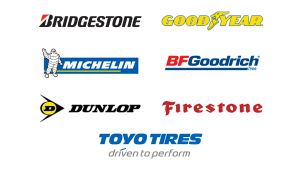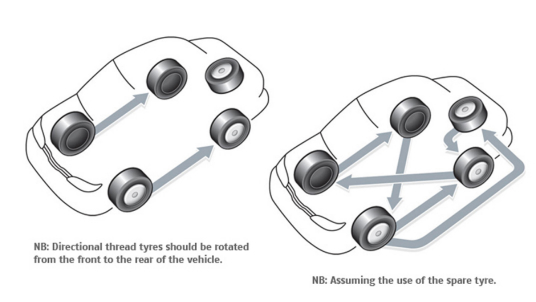Tyres

About Tyre Care and Safety
The condition of your car's tyres is an important element in the overall safety of you and your passengers. Tyres, although built to last, are subjected to all sorts of road conditions and driving styles, exposing them to extreme wear and tear.
There are some DIY checks that you can do between scheduled services to help ensure your tyres are safe and last as long as they should. In particular, maintaining the correct pressure is the most basic part of tyre care you can do yourself - and it makes a huge contribution to getting the best performance, economy and safety from your tyres.
Additionally, your driving style can affect the life and condition of your tyres. Smooth, attentive driving helps optimize tyre efficiency and lifespan, whereas an aggressive driving style will wear your tyres out much faster, regardless of whether you're driving with correct tyre pressure or wheel alignment.
How to Maintain Your Tyres
Check your tyre pressure regularly
- We recommend checking tyre pressure every week, while the tyres are cold - and don't forget the spare.
- Incorrect tyre pressure adversely affects grip on the road, ride comfort, fuel consumption and overall tyre performance.
- Different driving conditions require different pressures. For example, a higher pressure is usually recommended for high-speed driving or when carrying or towing a heavier than normal load.
- Under-inflated tyres, when used on hard roads (as opposed to sand or mud), can be unresponsive when steering and braking and lead to increased and uneven wear.
- Details relating to the correct pressure should be available from the tyre information placard on your vehicle.
Check tyre condition
- Tyres will wear with use and pre-maturely from poor alignment or erratic driving styles. To ensure safety, tyre tread depth must be at least 1.6mm or more to help ensure the tyre sticks to the road when braking, cornering and will help to avoid aquaplaning in wet conditions. Bald tyres (less than 1.6mm) are unsafe and need to be replaced immediately.
- In particular, tyre wear on front-wheel-drive vehicles is a little higher.
- Look for cracks and bulges in the side walls, and nails that may have pierced but not punctured the tyres.
Wheel Balance and Alignment
- During vehicle servicing, our technicians will check that all your wheels are precisely balanced, to ensure all sections of the tyre rotate evenly on the road, minimising undue wear.
- If required, we can check and realign your wheels, which is necessary when your vehicle tends to stray to the left or right when driving, or wanders about on a straight stretch of road.
- Correctly balanced and aligned wheels will ensure a Genuinely Better ride without vibrations. It will also aid in responsive steering and help you gain maximum mileage from your tyres.
- Wheel alignments can be necessary between scheduled servicing if you hit a curb or large pothole. Your wheel settings should be checked as soon as possible after such contact. Rough roads or aggressive driving can also be contributing factors.

Wheel Replacement and Selection
- If you need to replace a wheel due to damage or to enhance the appearance of your vehicle, we'll ensure the new wheels provide the same load capacity, diameter rim width and offset.
- It's important to be aware that differences in tyre type can adversely affect vehicle handling, wheel bearing life, brake cooling, headlight aim and the calibration of your speedometer.
- Your Service Centre can show you a comprehensive range of alloy wheels specifically designed for your car.
Alloy Wheels
- All cars have their own range of alloy wheels designed to enhance the appearance of each vehicle while maintaining performance and safety.
- If you install alloy wheels or have them rotated, we recommend that you recheck the tightness of the wheel nuts after the first week of driving.
- To help avoid damaging alloy wheels, use the car wheel nuts and wrench designed for your specific wheels.
Rotating Wheels
- To even out tyre wear across all tyres and extend tyre life, you should rotate your tyres from 5,000km, depending upon your driving habits and road conditions.
